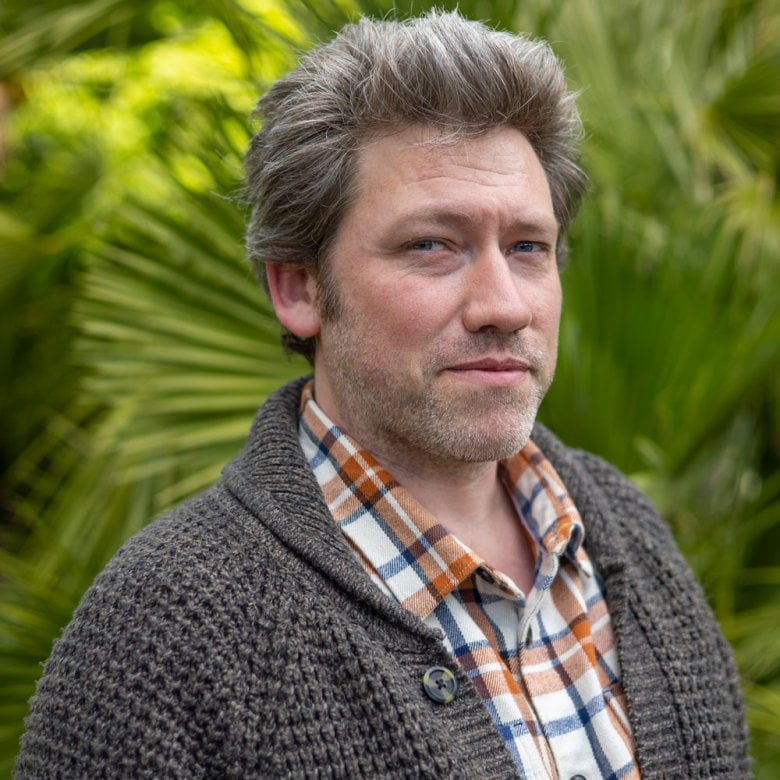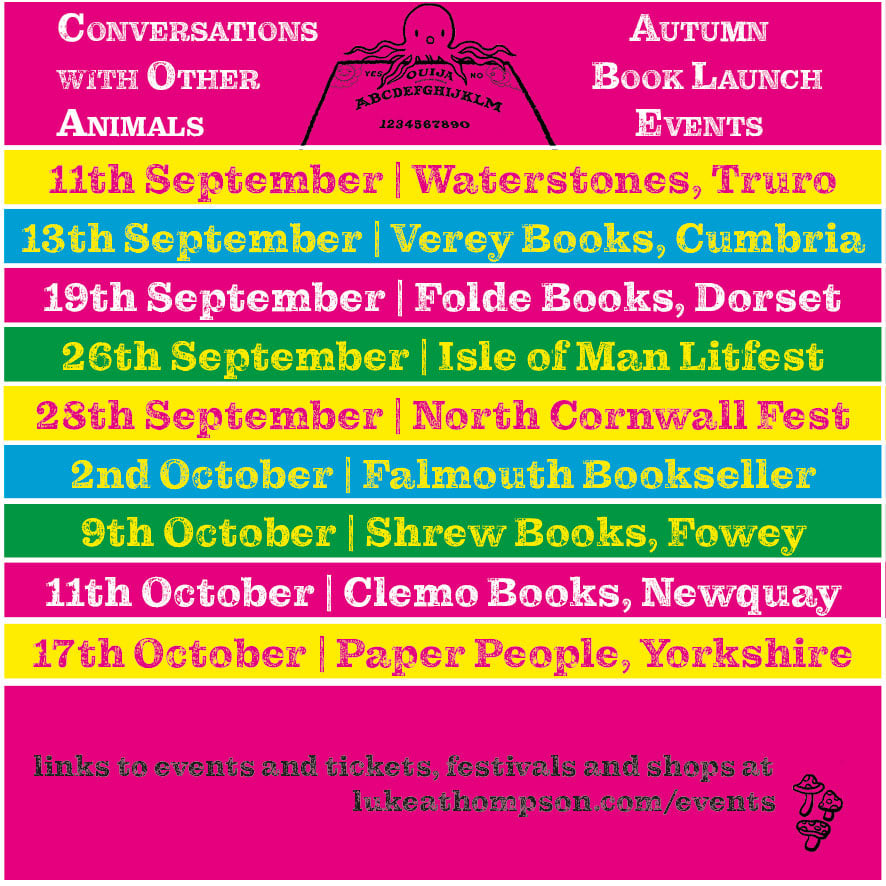Falmouth lecturer Luke Thompson to release book on conversing with animals
05 September 2024

Professional Writing MA lecturer Luke Thompson will release his new book, titled Domadomadoma-Blumblumblum: Conversations with Other Animals, on 5 September.
The book is a playful, cultural, and literary exploration of human attempts to converse with animals, and follows Luke as he embarks on an eccentric personal journey. The striking cover was illustrated by Cornwall-based artist Donya Todd.
We caught up with Luke ahead of his wide-ranging book tour that incorporates trips to Yorkshire and the Isle of Man, as well as a jaunt around Cornwall.
Tell us about your new book
It’s about talking to animals.
Or rather, it’s about conversing with other animals. Anyone who lives with a cat, or a dog, or a tortoise will talk to it now and then — ‘Good dog’, ‘Leave that mouse alone’, ‘You may be old enough to drive, but you don’t have a licence’ — but I was interested in the stories of when those animals talk back.
There’s a long history of this — thousands of years — so I cover a poltergeist mongoose on the Isle of Man, a Canadian Prime Minister who conversed with his dead dogs through spiritualists, a neurologist who tried to teach dolphins English and, when this failed, injected himself with ketamine to try communicating in a more speculative fashion, and lots more, alongside classic tales like the legends around King Solomon and Melampus.
I was interested in figuring out what the implications were of imagining a world in which other animals talk like humans and what conceptual framework we have to build to support such a picture of the world.

I also wanted to try the various techniques people have used to communicate with other species, including some of the more unusual practices. So yes, I did train as an animal psychic, spend hours in a floatation tank, and disappear into the wilderness with a crystal ball.
It was a lot of fun to write.
How does it compare with your other writing?
On the surface this one’s completely different from everything else. Previously I’ve written a collection of poetry and a couple of pamphlets of poetry, as well as a lengthy biography of a poet, and I’ve published (in the broader sense) performative works like a Phonetic Ouija Board and Psychic Test Cards for various events and exhibitions. They all sound quite different from a book about talking animals, don’t they. But what I’ve started to notice recently is that there’s a theme that goes back further than I thought—back to when I was young and first started reading and writing properly, as well as when I left work and travel and went to study philosophy at university. It’s about sense, language and the borders of what can and can’t be said. Poetry is always troubling these borders, taking language to new places, and that’s ultimately what this book is about too.
When and where do you write?
I am writing this at a spine-defying angle on the sofa at home. This is where I write up and where I tend to edit. But a good deal of the book was written out and about and in notebooks, whether that’s in the waiting room outside the floatation tanks or in an isolated hut in the Tamar Valley, where I was attempting to communicate with angels. (That hut was a great place to write—no electricity, no phone signal—amazing!)
When did you know you had a passion for writing?
Ach, I’ve always written. My father was a writer so it’s always been an acceptable and everyday thing. And always been recognised as a discipline, if that makes sense. The best lesson I think I learned from Dad about writing was the graft of it. When I was a child, he was always already downstairs on the sofa when we woke up, his A4 pad on his lap, writing with an implausibly sharp pencil, and he was usually in his study when we went to bed at night too. So I knew writing wasn’t just about having a good idea. My first idea of what writing was and what a writer was came from seeing this graft every day. I think that’s probably unusual.
But also, I think only quite recently I realised I was ‘a writer’ in a different way and that my ‘passion’, if you like, was also different. That is, you will always meet people who say they want to be a writer or that they are a writer, and you share stories or poems or you discuss books, and so on, and they might have tons of talent or an amazing way of seeing and describing the world or ideas, but then at some point, they slow down, or maybe they stop writing. Sometimes I think it might be the discipline of it. I don’t know. I don’t know if they give up or what happens really. I know life can get in the way, as some say, but I suppose what I’ve found is that it doesn’t work like that for me. Bits of my first book were written in the 15 or 30 minutes I had between the time I finished work at the fishmongers and the time my wife Sarah finished at the bakery. Poems in Singing About Melon were written while sitting up at night watching over Dad when he was dying of cancer. That’s not to say I’m a super-hard worker, but rather that writing is how I live. It’s a habit. A habit of thinking as much as a habit of doing.
And now just about every aspect of my life is books. I’m a writer, yes, but I’m also a publisher, an editor, a freelance book producer, and of course a teacher of writing. It’s all books.
The cover looks amazing! Could you tell us more about how the collaboration with Donya Todd came about?
Yes! Donya is a comics artist based in Cornwall and she’s phenomenal. There’s no mistaking Donya’s work.
I actually first became aware of Donya’s work while working with the National Trust and one of our writers at Falmouth, Wyl Menmuir. We invited artists on the MA Illustration: Authorial Practice course to pitch to illustrate a short story pamphlet by Wyl, and Donya was one of them. Donya’s work didn’t match what the Trust were after (‘Too many boobs’, as Donya put it later), but her work was so unlike anything else we saw that day that I soon commissioned her to illustrate four stories for my publishing company, Guillemot Press, instead. And they were wonderful.
We’ve stayed in touch since, occasionally working on little bits and pieces. Then, during the development of the cover for Domadomadoma, the publisher sent a list of wonderful cover artists together — all people they’d worked with before. Honestly, a brilliant line up of artists with phenomenal book design pedigrees. But then as a footnote, they said, ‘But it might also be fun to work with someone you know, so if you have any ideas…’
I sent them Donya’s work and here we are. It’s come out really well!
You're going on tour! What’s the route and where are your favourite places to visit?
It’s a jerky sort of tour. Basically two months of desultory travel. I’ve done events all over the place prior to this, but this is a more sustained assault on the public than anything I’ve done before.
I’m looking forward to talking to people about the book and I’m anxious about what they think of it and whether they enjoy it. I’ve no idea how comfortable I will be talking about it yet. I quite enjoy that uncertainty.
But I don’t really have a favourite place. I’m looking forward to them all and for different reasons. I’m looking forward to going back to the Isle of Man, where some of the book was written, to talk to them about their talking mongoose, and I’m looking forward to Yorkshire and Cumbria. (I feel strangely drawn to Yorkshire.) And I’m looking forward to visiting the bookshops in Cornwall, too. There are the established places like Falmouth Bookseller and Waterstones, but there are some really nice new places too, like Shrew Books in Fowey and Clemo Books in Newquay. I do have a list of these venues on my website if anyone’s wondering where, when and how to see what the book’s all about.





